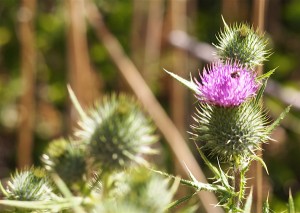The Thistles In Our Collaborative Divorce Garden
The Thistles In Our Collaborative Divorce Garden
by Lynette Berg Robe, Family Law Specialist
Law Offices of Lynette Berg Robe, Encino, California
Wildflowers are in abundance this time of year in Fryman Canyon, where I love to hike with my dogs on weekends. The little rain we received from the disappointing El Niño, inspired them: swathes of golden bush sunflowers, mounds of orange sticky monkey flowers, red heart-shaped penstemons, blue bush lupins. Then I see, in the middle of them, a bunch of prickly California thistles. I think, “ugh,” I hate thistles. They are thorny, both stalks and leaves full of stickers, and they move in and take over the other flowers, sucking up all the resources! How dare they mar this lovely landscape?
When I’m hiking my mind wanders, and the thistles make me think of Eeyore, the old grey donkey in the Winnie the Pooh and Christopher Robin books. Eeyore is kind of gloomy and depressive, a pessimist at heart. He is always expecting the worst to happen, waiting for the other shoe to drop, and his favorite food is appropriately masochistic: thistles. I look at them again, thinking what an unsavory meal to be anyone’s favorite food, imagining a bristly mouthful.
Then I notice the tiny little purple flowers starting to open in the midst of all those thorns. While not as bountiful as the other flowers, they are still kind of delicate and pretty if you take the time to look. Even though most animals (excepting Eeyore) won’t eat thistles, its flower nectar does attract bees and certain butterflies.
My mind, wandering again, goes to our Collaborative Practice and a recent discussion at a Family Divorce Solutions meeting.
We, too, can encounter thistles among our Collaborative flowers.
In Collaborative Practice, attorneys assume a somewhat different role than in traditional negotiation or in litigation. In Collaborative Practice, attorneys are supposed to help their clients focus on their interests and to try to find out of the box solutions that will work for the entire family. Not surprisingly, one of the parties, or sometimes both, may be a thistle: thorny, defensive, hard, even painful to appreciate.
In traditional litigation and negotiation practice, attorneys can act as thistles themselves, being irritating, intimidating, obnoxiously attacking the other party and his or her attorney, seeking to undermine their positions. In Collaborative Practice, the attorney’s job is not to undermine opposing counsel, their clients, or their positions. Rather, the attorney tries to empower his or her own client to express the client’s interests and reasoning, as well as fostering an environment where everyone including the other spouse can express themselves. Thistles make the Collaborative Process more stressful, and divorce coaches and other team members in the case can be very helpful in creating a productive environment for the couple to be able to express themselves, reducing the stress, and preventing the case from falling out of the Collaborative Process into litigation.
An individual engaged in the Collaborative Process may remain suspicious of the other spouse’s attorney. Their only experience may be the traditional role of the attorney in litigation, so they expect the other party’s attorney to be threatening, devious, and untrustworthy.
One of my Family Divorce Solutions colleagues made a comment which stayed with me. She described a Collaborative meeting where it became clear the other party did not trust her and behaved like a true thistle. When she saw that nothing she could say would change the other party’s erroneous perception of her role in as a Collaborative Process attorney, she decided to simply sit and be silent the rest of the session. She allowed her own client to respond to the spouse. My colleague focused on supporting her client and the overall Collaborative Process in the best way possible, which did not include assuming an adversarial role with the thorny opposing party. As a Collaborative attorney, her priority was to help her client articulate and express his interests and to promote an environment where the couple would be able to reach an agreement.
Clients who are human thistles are a challenge. We have a natural bias against them because of their prickly attitudes, and they make our Collaborative Process more difficult. Collaborative professionals need to look for the flowers. Before their separation, the thistle was once loved and admired by the other spouse. We need to remember that even an obnoxious weed can have its charms!


